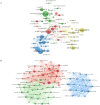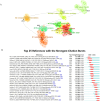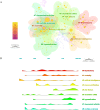Artificial intelligence in autoimmune diseases: a bibliometric exploration of the past two decades
- PMID: 40330462
- PMCID: PMC12052778
- DOI: 10.3389/fimmu.2025.1525462
Artificial intelligence in autoimmune diseases: a bibliometric exploration of the past two decades
Abstract
Objective: Autoimmune diseases have long been recognized for their intricate nature and elusive mechanisms, presenting significant challenges in both diagnosis and treatment. The advent of artificial intelligence technology has opened up new possibilities for understanding, diagnosing, predicting, and managing autoimmune disorders. This study aims to explore the current state and emerging trends in the field through bibliometric analysis, providing guidance for future research directions.
Methods: The study employed the Web of Science Core Collection database for data acquisition and performed bibliometric analysis using CiteSpace, HistCite Pro, and VOSviewer.
Results: Over the past two decades, 1,695 publications emerged in this research field, including 1,409 research articles and 286 reviews. This investigation unveils the global development landscape predominantly led by the United States and China. The research identifies key institutions, such as Brigham & Women's Hospital, influential journals like the Annals of the Rheumatic Diseases, distinguished authors including Katherine P. Liao, and pivotal articles. It visually maps out the research clusters' evolutionary path over time and explores their applications in patient identification, risk factors, prognosis assessment, diagnosis, classification of disease subtypes, monitoring and decision support, and drug discovery.
Conclusion: AI is increasingly recognized for its potential in the field of autoimmune diseases, yet it continues to face numerous challenges, including insufficient model validation and difficulties in data integration and computational power. Significant advancements have been demanded to enhance diagnostic precision, improve treatment methodologies, and establish robust frameworks for data protection, thereby facilitating more effective management of these complex conditions.
Keywords: artificial intelligence; autoimmune diseases; bibliometric exploration; content analysis; forefront.
Copyright © 2025 Liu, Liu, Li, Shang, Cao, Shen and Huang.
Conflict of interest statement
The authors declare that the research was conducted in the absence of any commercial or financial relationships that could be construed as a potential conflict of interest.
Figures










Similar articles
-
Research Trends in the Application of Artificial Intelligence in Oncology: A Bibliometric and Network Visualization Study.Front Biosci (Landmark Ed). 2022 Aug 31;27(9):254. doi: 10.31083/j.fbl2709254. Front Biosci (Landmark Ed). 2022. PMID: 36224012
-
Application of artificial intelligence in rheumatic disease: a bibliometric analysis.Clin Exp Med. 2024 Aug 23;24(1):196. doi: 10.1007/s10238-024-01453-6. Clin Exp Med. 2024. PMID: 39174664 Free PMC article.
-
Global trend analysis, mechanistic insights and future directions of autoimmune ear diseases: Based on comprehensive findings over the past 20 years.Autoimmun Rev. 2024 Dec;23(12):103679. doi: 10.1016/j.autrev.2024.103679. Epub 2024 Nov 8. Autoimmun Rev. 2024. PMID: 39521364 Review.
-
The published role of artificial intelligence in drug discovery and development: a bibliometric and social network analysis from 1990 to 2023.J Cheminform. 2025 May 8;17(1):71. doi: 10.1186/s13321-025-00988-4. J Cheminform. 2025. PMID: 40341055 Free PMC article.
-
Application of artificial intelligence in the health management of chronic disease: bibliometric analysis.Front Med (Lausanne). 2025 Jan 7;11:1506641. doi: 10.3389/fmed.2024.1506641. eCollection 2024. Front Med (Lausanne). 2025. PMID: 39839623 Free PMC article.
References
-
- Sadeghi P, Karimi H, Lavafian A, Rashedi R, Samieefar N, Shafiekhani S, et al. . Machine learning and artificial intelligence within pediatric autoimmune diseases: applications, challenges, future perspective. Expert Rev Clin Immunol. (2024) 20:1219–36. doi: 10.1080/1744666X.2024.2359019 - DOI - PubMed
Publication types
MeSH terms
LinkOut - more resources
Full Text Sources
Medical
Miscellaneous

